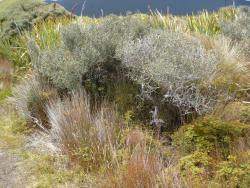- Taxon
- Gallery
Classification
Nomenclature
Scientific Name:
Olearia virgata (Hook.f.) Hook.f., Handb. New Zealand Fl. 128 (1864)
Synonymy:
- ≡ Eurybia virgata Hook.f., Bot. Antarct. Voy. II. (Fl. Nov.-Zel.) Part I, 118 (1852)
- = Olearia ramuliflora Colenso, Trans. & Proc. New Zealand Inst. 22: 467 (1889 [1890])
- ≡ Olearia virgata var. ramuliflora (Colenso) Kirk, Stud. Fl. New Zealand 276 (1899)
- = Olearia aggregata Colenso, Trans. & Proc. New Zealand Inst. 28: 597 (1895 [1896])
- = Olearia parvifolia Colenso, Trans. & Proc. New Zealand Inst. 28: 598 (1895 [1896])
- = Olearia virgata var. implicita G.Simpson, Trans. Roy. Soc. New Zealand 75: 199 (1945)
- ≡ Olearia virgata subsp. implicita (G.Simpson) Heads, Bot. J. Linn. Soc. 127: 275-277 (1998)
- = Olearia serpentina G.Simpson, Trans. Roy. Soc. New Zealand 75: 200 (1945)
- ≡ Olearia virgata var. serpentina (G.Simpson) Allan, Fl. New Zealand 1, 671 (1961)
- ≡ Olearia virgata subsp. serpentina (G.Simpson) Heads, Bot. J. Linn. Soc. 127: 277-278 (1998)
- = Olearia virgata subsp. centralis Heads, Bot. J. Linn. Soc. 127: 279-282 (1998)
Vernacular Name(s):
Twiggy tree daisy
Description
Slender ± divaricate shrub up to c. 2.5 m. tall; branches slender, ± virgate; branchlets 4-angled, sulcate, elongate, opp., ± divaricate, pilose when young. Lvs in small opp. fascicles or occ. paired, 5–10–(20) × 3–5–(8) mm., entire, obovate to narrow-obovate, obtuse, subcoriac., glab. or nearly so above, clad in soft appressed white to buff tomentum below; petioles c. 1 mm. long. Capitula ± 8–9 mm. diam., in opp. fascicles or paired, on slender bracted or nude tomentose pedicels. Phyll. short, woolly-tomentose, in 2–(4) series. Ray-florets few, ligulate; disk-florets 6–8. Pappus-hairs white to reddish; achenes puberulous.
[From: Allan (1961) Flora of New Zealand. Volume 1.]
Biostatus
Indigenous (Endemic)
Phenology
Flowering: Oct.–Jan.; Fruiting: Dec.–Feb.
Bibliography
Colenso, W. 1890: A description of some newly-discovered Phænogamic plants, being a further contribution towards the making-known the botany of New Zealand. Transactions and Proceedings of the New Zealand Institute 22: 459–493.
Colenso, W. 1896: Phænogams: A description of a few more newly-discovered indigenous plants; being a further contribution towards the making known the botany of New Zealand. Transactions and Proceedings of the New Zealand Institute 28: 591–613.
de Lange, P.J.; Rolfe, J.R.; Barkla J.W.; Courtney, S.P.; Champion, P.D.; Perrie, L.R.; Beadel, S.N.; Ford, K.A.; Breitwieser, I.; Schönberger, I.; Hindmarsh-Walls, R.; Heenan, P.B.; Ladley, K. 2018: Conservation status of New Zealand indigenous vascular plants, 2017. New Zealand Threat Classification Series. No. 22. [Not Threatened]
de Lange, P.J.; Rolfe, J.R.; Champion, P.D.; Courtney, S.P.; Heenan, P.B.; Barkla, J.W.; Cameron, E.K.; Norton, D.A.; Hitchmough, R.A. 2013: Conservation status of New Zealand indigenous vascular plants, 2012. New Zealand Threat Classification Series 3. Department of Conservation, Wellington. [Not Threatened]
Heads, M. 1998: Biodiversity in the New Zealand divaricating tree daisies: Olearia sect. nov. (Compositae). Botanical Journal of the Linnean Society 127(3): 239–285.
Heenan, P.B. 2001: Natural variation in Olearia virgata (Asteraceae). New Zealand Journal of Botany 39(3): 381–393.
Hooker, J.D. 1852–1853 ("1853"): The Botany of the Antarctic Voyage of H.M. Discovery Ships Erebus and Terror in the Years 1839–1843, under the command of Captain Sir James Clark Ross. II. Flora Novae-Zelandiae. Part I. Flowering plants. Lovell Reeve, London.
Hooker, J.D. 1864: Handbook of the New Zealand Flora: a systematic description of the native plants of New Zealand and the Chatham, Kermadec's, Lord Auckland's, Campbell's and Macquarie's Islands. Part I. Reeve, London.
Kirk,T. 1899: The Students' Flora of New Zealand and the Outlying Islands. Government Printer, Wellington, N.Z.
Simpson, G. 1945: Notes on Some New Zealand Plants and Descriptions of New Species (No. 4). Transactions of the Royal Society of New Zealand 75: 187–202.




